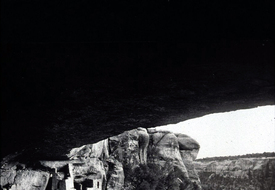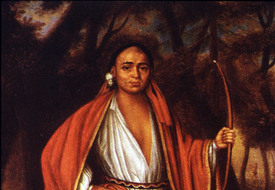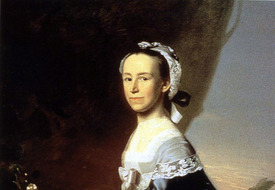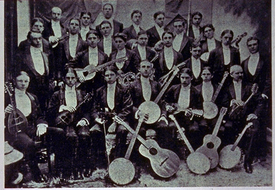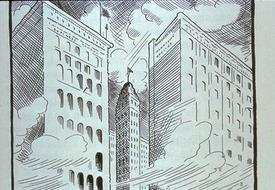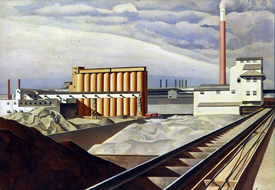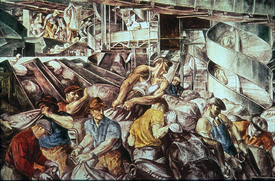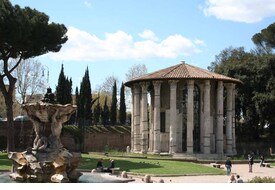Anasazi Ruins at Mesa Verde, AD 100 to 1300
Image ID: 13068
Collection: Alan Taylor
Topic(s): Colonies, Arts and Architecture, Indian Americans
Region(s): North America
CA Standard(s): 5.1 - The major pre-Columbian settlements…
National Standard(s): Three Worlds Meet (Beginnings to 1620) , Intensified Hemispheric Interactions 1000-1500 CE, Expanding Zones of Exchange and Encounter 300-1000 CE
Card Text: "Anasazi" ruins at Mesa Verde, AD/CE 100 - 1300.
Citation: American Museum of Natural History, Central Park W at 79th St, New York, NY 10024-5192. Neg. #31640. In Betty and Ian Ballantine, eds., "The Native Americans: An Illustrated History" (Turner Publishing, Inc., 1050 Techwood Dr NW, Atlanta, GA 30318) 1993, pp. 22-23.
Verelst, Ho Nee Yeath Taw No Row, King of Generethgarich (Iroquois John), 1710
Image ID: 12655
Collection: Alan Taylor
Topic(s): Colonies, Arts and Architecture, Indian Americans, Native Americans
Region(s): North America
CA Standard(s): 5.3 - The cooperation and conflict among the American Indians and between the Indian nations and the new settlers, 5.3 - The cooperation and conflict among the American Indians and between the Indian nations and the new settlers
National Standard(s): Colonization and Settlement (1585-1763)
Card Text: Jan Verelst, "Ho Nee Yeath Taw No Row, King of Generethgarich," a pro-English Mohawk and diplomat, 1710. He was one of four Native American envoys sent to London to request Britain's recognition of the Iroquois Confederation as a sovereign nation, and for military aid against the French. Oil on canvas.
Citation: Copyright © Library and Archives Canada, 395 Wellington St, Ottawa, ON K1A 0N4 CANADA. Gift of Queen Elizabeth II, 1977. All rights reserved.
Copley, Mercy Otis Warren, c. 1763
Image ID: 12454
Collection: Alan Taylor
Topic(s): Revolution, Arts and Architecture
Region(s): North America
CA Standard(s): 5.6 - The course and consequences of the American Revolution, 8.1 - Major events preceding the founding of the nation and the development of American constitutional democracy, 11.1 - The significant events in the founding of the nation and its attempts to realize the philosophy of government described in the Declaration of Independence
National Standard(s): Revolution and the New Nation (1754-1820s)
Card Text: John Singleton Copley, "Mercy Otis Warren," a prolific American author, historian, patriot, and revolutionary. Oil on canvas, c. 1763.
Citation: Copyright © Museum of Fine Arts, Avenue of the Arts, 465 Huntington Ave, Boston, MA 02115-5597. Bequest of Winslow Warren, 1931. Acc. No. 31.212. All rights reserved.
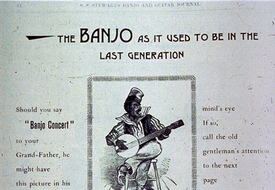
Ad: 'The BANJO as it used to be in the last generation' 1893
Image ID: 3863
Collection: Roland Marchand
Topic(s): Sports and Recreation, Popular recreation 1870-1920, Arts and Architecture
Region(s): United States
CA Standard(s): 11.2 - The the relationship among the rise of industrialization, large-scale rural-to-urban migration, and massive immigration from Southern and Eastern Europe
National Standard(s): The Emergence of Modern America (1890-1930), The Development of the Industrial United States (1870-1900)
Card Text: "The BANJO as it used to be in the last generation…" A picture of an old, black-faced minstrel. "The banjo was once monopolized by the Negro Minstrel Performers, and hence it became associated with black face, and was sometimes called the 'Negro instrument.' The banjo of today is altogether another instrument...Should you say 'Banjo Concert' to your Grand-father, he might have this picture in his mind's eye. If so, call the old gentleman's attention to the next page..." 1893.
Citation: Stewart's Banjo and Guitar Journal, Dec. 1893. In Karen Linn, "That Half-Barbaric Twang," 1991, p. 21.
College Banjo Clubs, 1890's
Image ID: 3857
Collection: Roland Marchand
Topic(s): Sports and Recreation, Popular recreation 1870-1920, Arts and Architecture
Region(s):
CA Standard(s): 11.2 - The the relationship among the rise of industrialization, large-scale rural-to-urban migration, and massive immigration from Southern and Eastern Europe
National Standard(s):
Card Text: College banjo clubs. At top, "Georgetown Club of 1897." Below, "Brown University Club of 1891."
Citation: Top: Georgetown University Archives, Georgetown University, 37th and O Streets, NW, Washington, DC 20057. Bottom: Brown University Library, Brown University, Providence, RI 02912. In Karen Linn, "That Half-Barbaric Twang," 1991, p. 26.
11.2.2
'Nearer My God to Thee' 1913
Image ID: 4213
Collection: Roland Marchand
Topic(s): Religion, Social Gospel and Missions, Arts and Architecture
Region(s): United States
CA Standard(s): 11.3 - The role of religion in the founding of America and its lasting moral, social, and political impacts, and issues regarding religious liberty.
National Standard(s):
Card Text: "Nearer My God to Thee," 1913. A tiny church is overwhelmed by the enormous skyscrapers of capitalist America.
Citation: Copyright holder unknown. Art Young drawing. In The Masses, Dec. 1913. In Echoes of Revolt: The Masses, 1911-1917, Chicago, 1966, p. 222.
11.3.1
Charles Sheeler, 'Classic Landscape' 1931
Image ID: 9848
Collection: Karen Halttunen
Topic(s): Nineteenth and Twentieth Century, Twentieth Century Painting, Arts and Architecture
Region(s): United States
CA Standard(s): 11.5 - Major political, social, economic, technological, and cultural developments of the 1920s.
National Standard(s): The Emergence of Modern America (1890-1930), The Great Depression and World War II (1929-1945)
Card Text: Charles Sheeler, "Classic Landscape," 1931, oil on canvas, 63.5 x 81.9 cm (25 x 32 1/4 in.)
Citation: Copyright National Gallery of Art, 2000B South Club Dr, Landover, MD 20785. Collection of Barney A. Ebsworth. 2000.39.2. All rights reserved. www.nga.gov
'Sorting Mail' 1935
Image ID: 3076
Collection: Roland Marchand
Topic(s): Urbanization, Positive view, Arts and Architecture
Region(s): United States
CA Standard(s): 11.6 - The Great Depression and how the New Deal changed the role of the federal government
National Standard(s): The Great Depression and World War II (1929-1945)
Card Text: Reginald Marsh, "Sorting Mail," 1935.
Citation: The Post Office Department Building, 12th Street and Pennsylvania Ave. NW, Washington, DC. In Eds. of Time-Life Books, "Modern American Painting," 1977, p. 80.
11.6.4
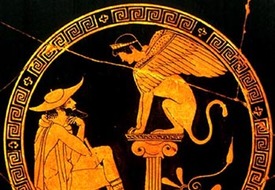
Oedipus and Sphinx
Image ID: 11154
Collection: Joan Cadden
Topic(s): Mythology, Arts and Architecture, Greece Ancient
Region(s): Europe
CA Standard(s): 6.4 - The geographic, political, economic, religious, and social structures of the early civilizations of Ancient Greece
National Standard(s): Classical Traditions, Major Religions and Giant Empires, 1000 BCE-300 CE
Card Text: Oedipus and the Sphinx of Thebes. Seated on a rock and dressed in traveler's cape and hat, Oedipus ponders the riddle of the Sphinx. She sits on a plinth; she has the head and chest of a woman, bird wings, lion claws, and a dog's body. She asks passers-by to solve a riddle. If they fail, she destroys or devours them. "What goes on four feet in the morning, two feet at noon, and three feet in the evening?" When Oedipus answers correctly, the Sphinx is so angry that she kills herself. Oedipus travels on to Thebes. Attic red-figure cup (kylix) by the Oedipus Painter, tondo, c. 470 BCE, Classical Period.
Citation: 40+ online. Copyright © Vatican Museums, Museo Gregoriano Etrusco Vaticano, 00120 Vatican City, Città del Vaticano, Vatican City State, EUROPE. Cat. No. 16541. All rights reserved. Beazley Archive No. 205372.
Heracles Slaying Nessos
Image ID: 11134
Collection: Joan Cadden
Topic(s): Mythology, Arts and Architecture, Arts and Architecture
Region(s): Europe
CA Standard(s): 6.4 - The geographic, political, economic, religious, and social structures of the early civilizations of Ancient Greece
National Standard(s): Classical Traditions, Major Religions and Giant Empires, 1000 BCE-300 CE
Card Text: Heracles slaying Nessos the Centaur with his sword, and grasping him by the hair. Attic black-figure storage jar (neck amphora) attributed to the Nettos (or Nessos) Painter, c. 550-520 BCE, Archaic Period. Found at a tomb in Athens; 1.22 m high.
Citation: 12+ online. GNU Free Documentation License. Marcus Cyron/Greece 2008. Creative Commons Attribution-Share Alike 3.0 Unported License. Copyright © National Archaeological Museum, 44, Patission St, Athens 10682, GREECE. 1002. Cat. No. CC657. All rights reserved. Beazley Archive No. 300025.
Temple of Heracles the Victor, Rome, 2nd c. BCE
Image ID: 10955
Collection: Joan Cadden
Topic(s): Mythology, Arts and Architecture
Region(s): Europe
CA Standard(s): 6.7 - The geographic, political, economic, religious, and social structures during the development of Rome, 7.1 - The causes and effects of the vast expansion and ultimate disintegration of the Roman Empire.
National Standard(s): Classical Traditions, Major Religions and Giant Empires, 1000 BCE-300 CE
Card Text: The Temple of Heracles the Victor is the oldest surviving marble building in Rome. A round temple of Greek design, surrounded by colonnades, it was mistaken for a temple of Vesta for many years. Late 2nd c. BCE, Hellenistic; in the Forum Boarium, near the Tiber.
Citation: Photographer and copyright holder unknown.
Heracles Slaying Nessos
Image ID: 11134
Collection: Joan Cadden
Topic(s): Mythology, Arts and Architecture, Arts and Architecture
Region(s): Europe
CA Standard(s): 6.4 - The geographic, political, economic, religious, and social structures of the early civilizations of Ancient Greece
National Standard(s): Classical Traditions, Major Religions and Giant Empires, 1000 BCE-300 CE
Card Text: Heracles slaying Nessos the Centaur with his sword, and grasping him by the hair. Attic black-figure storage jar (neck amphora) attributed to the Nettos (or Nessos) Painter, c. 550-520 BCE, Archaic Period. Found at a tomb in Athens; 1.22 m high.
Citation: 12+ online. GNU Free Documentation License. Marcus Cyron/Greece 2008. Creative Commons Attribution-Share Alike 3.0 Unported License. Copyright © National Archaeological Museum, 44, Patission St, Athens 10682, GREECE. 1002. Cat. No. CC657. All rights reserved. Beazley Archive No. 300025.
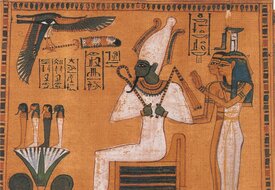
Osiris on the Throne Surrounded by Isis, Nephthys and Horus
Image ID: 11182
Collection: Joan Cadden
Topic(s): Religion, Mythology, Arts and Architecture
Region(s): Africa
CA Standard(s): 6.2 - The geographic, political, economic, religious, and social structures of the early civilizations of Mesopotamia, Egypt, and Kush
National Standard(s): Early Civilizations and the Emergence of Pastoral Peoples, 4000-1000 BCE
Card Text: Osiris on the throne surrounded by Isis, Nephthys and Horus, the son of Isis. A fragment of the Egyptian Book of the Dead. With the counsel of Isis and Nephthys, Osiris judged the dead, deciding who proceeded into everlasting life or damnation. Here Horus in falcon form brings a deceased before the shrine of Osiris. The four sons of Horus stand on a lotus flower growing out of the waters beneath the throne. 1240 BCE.
Citation: 9 online. E.A. Wallis Budge, trans., "Egyptian Book of the Dead, The Papyrus of Ani," (The Medici Society, 19-23 White Lion St, Islington, London N1 9PD England, UNITED KINGDOM, 1913).
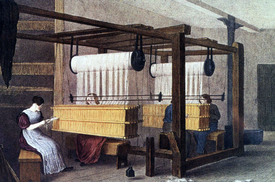
Female and Child Factory Workers Reeding or Drawing in at Loom, England, 1840
Image ID: 8331
Collection: Karen Halttunen
Topic(s): Nineteenth Century, Lowell, Agriculture, Arts and Architecture, British Empire, Business 19th century, Child labor, Class Structure, Cooption of styles, Corporate Image, Early mills and factories, Early National Period, Emerging industrial city, Environmental History, Factory as symbol, Gender-Bending, Imperialism, Industrial Revolution, Institutions and social disorder, Invention, Labor, Labor Organizations and Leaders, Market Economy, National Events, Nineteenth Century Children, Nineteenth Century Furniture, Nineteenth Century Interiors, Strikes and Violence, Success 19th century, Sweatshops, Technology, Urbanization, Victorian Culture, Women and Health, Women in labor movement, Women's organizations, Women's work, Work and Housing, Work and Workers
Region(s): United States, Europe
CA Standard(s): 8.6 - The divergent paths of the American people from 1800 to the mid-1800s...with emphasis on the Northeast. , 5.8 - The colonization, immigration, and settlement patterns of the American people from 1789 to the mid-1800s..., 7.10 - The historical developments of the Scientific Revolution and its lasting effect on religious, political, and cultural institutions, 10.3 - The effects of the Industrial Revolution in England, France, Germany, Japan, and the United States. , 10.4 - Global change in the era of New Imperialism in Africa, Southeast Asia, China, India, Latin America, and the Philippines
National Standard(s): Expansion and Reform (1801-1861)
Card Text: Female and child factory workers reeding or drawing in at large cotton loom, England, 1840. Thread reeding is the process of arranging fabric threads on a loom in the correct order before weaving begins. Reeding allows the same loom to make both very fine and very coarse fabric, and to weave threads at very different densities.
"The Beam full of yarn, after being dressed with size to stiffen and strengthen the threads, is brought to the Drawing-in Frame, and hung up as you see in the picture, the Healds which are made of twisted worsted, or Cotton, are hung under the beam and weighted below. The ends of the warp are then drawn down, and the rods hung up to preserve the lease, or the warp could not be woven. There is a female at each side of the healds; one takes hold of the ends of the warp, and gives them separately to the other, who draws them through the healds. When all the ends are through, the Drawing-in is completed. Next comes the Reeding; a reed consists of a great number of short flat pieces of steel or brass called Dents, fixed at short and equal distances from each other, in long pieces of split cane, and tightly secured with a wax band. Through each space, between the dents, two ends are drawn by a small hook, called a Reed-hook. It is not always necessary to draw the warps in; they can also be twisted in, that is, when the warp is nearly all woven into cloth by the weaver, the yarn is cut off, and the fresh warp twisted to the old one. Drawing-in and Reeding is very tedious work and requires great care, there are not only a great number of threads to draw in and reed, but if they were to miss one dent or one heald, it is probable that the whole or a part of the work would have to be done over again. Since this is the case, the steady, careful look of the girls is not to be wondered at."
"Factory Rules from the Handbook to Lowell, 1848: REGULATIONS TO BE OBSERVED by all persons employed in the factories of the Hamilton Manufacturing Company. The overseers are to be always in their rooms at the starting of the mill, and not absent unnecessarily during working hours. They are to see that all those employed in their rooms, are in their places in due season, and keep a correct account of their time and work. They may grant leave of absence to those employed under them, when they have spare hands to supply their places, and not otherwise, except in cases of absolute necessity. All persons in the employ of the Hamilton Manufacturing Company, are to observe the regulations of the room where they are employed. They are not to be absent from their work without the consent of the over-seer, except in cases of sickness, and then they are to send him word of the cause of their absence. They are to board in one of the houses of the company and give information at the counting room, where they board, when they begin, or, whenever they change their boarding place; and are to observe the regulations of their boarding-house. Those intending to leave the employment of the company are to give at least two weeks' notice thereof to their overseer. All persons entering into the employment of the company, are considered as engaged for twelve months, and those who leave sooner, or do not comply with all these regulations, will not be entitled to a regular discharge. The company will not employ anyone who is habitually absent from public worship on the Sabbath, or known to be guilty of immorality. A physician will attend once in every month at the counting-room, to vaccinate all who may need it, free of expense. Anyone who shall take from the mills or the yard, any yarn, cloth or other article belonging to the company, will be considered guilty of stealing and be liable to prosecution. Payment will be made monthly, including board and wages. The accounts will be made up to the last Saturday but one in every month, and paid in the course of the following week. These regulations are considered part of the contract, with which all persons entering into the employment of the Hamilton Manufacturing Company, engage to comply. JOHN AVERY, Agent."
"… Miss Sarah G. Bagl[e]y said she had worked in the Lowell Mills eight years and a half, six years and a half on the Hamilton Corporation, and two years on the Middlesex. She is a weaver, and works by the piece. She worked in the mills three years before her health began to fail. She is a native of New Hampshire, and went home six weeks during the summer. Last year she was out of the mill a third of the time. She thinks the health of the operatives is not so good as the health of females who do housework or millinery business. The chief evil, so far as health is concerned, is the shortness of time allowed for meals. The next evil is the length of time employed - not giving them time to cultivate their minds. She spoke of the high moral and intellectual character of the girls. That many were engaged as teachers in the Sunday schools. That many attended the lectures of the Lowell Institute; and she thought, if more time was allowed, that more lectures would be given and more girls attend. She thought that the girls generally were favorable to the ten hour system. She had presented a petition...to 132 girls, most of whom said that they would prefer to work but ten hours. In a pecuniary point of view, it would be better, as their health would be improved. They would have more time for sewing. Their intellectual, moral and religious habits would also be benefited by the change."
Citation: J.R. Barfoot, "The Progress of Cotton, 1835-40," #9: "Reeding or Drawing in," in a series of 12 prints. Slater Mill Historic Site, 67 Roosevelt Ave, Pawtucket, RI 02860. First text: Public domain: "The Progress of Cotton No. 9: Reading or Drawing In," 1840. From Barfoot's series of colored lithographs of 1840 depicting the cotton manufacturing process. Original text written to accompany Lithograph No.9. https://www.flickr.com/photos/ manchesterarchiveplus/6503188589/in/album-72157629084961692/. Manchester Archives, Manchester Central Library, Manchester City Council, Town Hall, Albert Square, Manchester M60 2LA, UNITED KINGDOM. Second text: Public domain: "Factory Rules from the Handbook to Lowell, 1848." https: //chnm.gmu.edu/mcpstah/wordpress/wp-content/themes/tah/files/mckee_primary-sources.pdf. Roy Rosenzweig Center for History and New Media, Department of History and Art History, George Mason University, 4400 University Dr, MSN 1E7, Fairfax, VA 22030. Third text: Public domain.
"Report," Massachusetts House Document, no. 50, March, 1845. https://archives.lib.state.ma.us/bitstream/handle/2452/755732/ocm39986872-1845-HB-0050.pdf?sequence=1&isAllowed=y. State Library of Massachusetts, 24 Beacon St, State House Rm 341, Boston, MA 02133. Sept 7, 2023.
